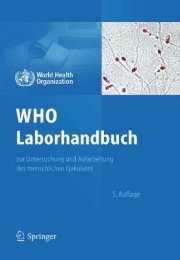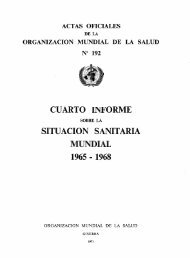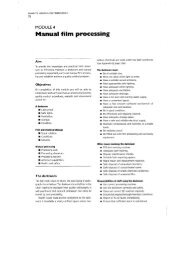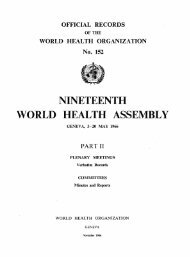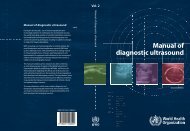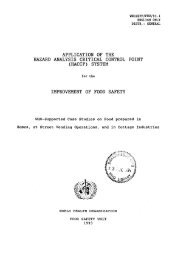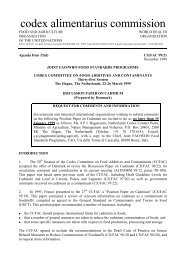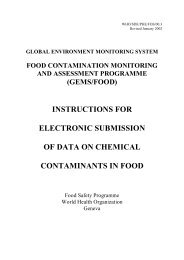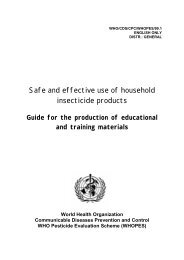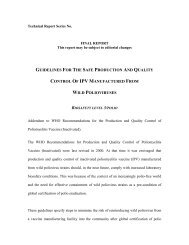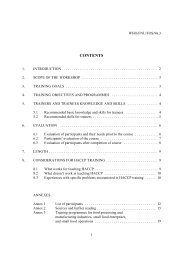WHO Drug Information Vol. 20, No. 4, 2006 - World Health ...
WHO Drug Information Vol. 20, No. 4, 2006 - World Health ...
WHO Drug Information Vol. 20, No. 4, 2006 - World Health ...
Create successful ePaper yourself
Turn your PDF publications into a flip-book with our unique Google optimized e-Paper software.
Safety and Efficacy Issues<br />
Leflunomide and peripheral<br />
neuropathy<br />
Australia — Leflunomide is a disease<br />
modifying anti-rheumatic prodrug<br />
(DMARD) with immunosuppressive<br />
properties. It has been available in<br />
Australia since <strong>20</strong>00 for the treatment of<br />
active rheumatoid arthritis.<br />
To date, ADRAC has received 659<br />
reports in association with leflunomide,<br />
30 of which described neuropathy or<br />
peripheral neuropathy. Leflunomide was<br />
the sole suspected drug in 24 of these<br />
cases. Ages ranged from 33 to 90 years.<br />
The daily dose of leflunomide was <strong>20</strong> mg<br />
in 24 cases, 10 mg in 1, 30 mg in 1, and<br />
not stated in the remaining cases. The<br />
time to onset (n=21) ranged from 2<br />
weeks to <strong>20</strong> months.<br />
Most reports described insidious onset<br />
of bilateral sensory changes such as<br />
numbness, hypoaesthesia, paraesthesia,<br />
or painful burning sensations affecting<br />
the feet and (in a few cases) the hands.<br />
Clinical findings variously included<br />
reduced sensation to light touch and pin<br />
prick, decreased vibration sense distally,<br />
and in one case ‘foot drop’ was noted.<br />
Decreased or absent tendon reflexes<br />
were also noted in some cases.<br />
Nine reports included the results of nerve<br />
conduction studies which supported a<br />
diagnosis of significant length-dependent<br />
sensory or sensorimotor neuropathy.<br />
Symptoms persisted and became worse<br />
with continued use of leflunomide in<br />
several cases.<br />
Recovery was documented after withdrawal<br />
of leflunomide in 6 patients, 3<br />
of whom were treated with ‘cholestyramine<br />
washout’ (which reduces the<br />
elimination half-life of the active metabolite<br />
of leflunomide from more than one<br />
week to about one day). At the time of<br />
256<br />
<strong>WHO</strong> <strong>Drug</strong> <strong>Information</strong> <strong>Vol</strong> <strong>20</strong>, <strong>No</strong>. 4, <strong>20</strong>06<br />
reporting, 15 patients had not recovered<br />
and the outcome was unknown for the<br />
remaining cases.<br />
The cases reported to ADRAC are similar<br />
to those recently described by Martin et al<br />
(1). The temporal association of leflunomide<br />
with peripheral neuropathy and<br />
recovery on dechallenge suggest a<br />
causal relationship. The clinical features<br />
resemble the sensory peripheral neuropathy<br />
attributable to the vasculitic component<br />
of rheumatoid disease itself. Accordingly,<br />
the association may be difficult to<br />
recognise but prescribers should consider<br />
the possible role of leflunomide in patients<br />
who complain of sensory problems<br />
in the feet because in such cases the<br />
condition is potentially reversible if the<br />
drug is ceased.<br />
Extracted from Australian Adverse <strong>Drug</strong><br />
Reactions Bulletin, <strong>Vol</strong>ume 25, Number 5,<br />
October <strong>20</strong>06.<br />
Reference<br />
1. Martin, K et al. Neuropathy associated with<br />
leflunomide: a case series. Ann Rheum Dis<br />
<strong>20</strong>05; 64: 649-50.<br />
Ezetimibe and depression?<br />
Australia — Ezetimibe (Ezetrol®) was<br />
registered in Australia in June <strong>20</strong>03 for<br />
treatment of hypercholesterolaemia.<br />
Since then, ADRAC has received 265<br />
reports of suspected adverse reactions<br />
associated with the use of this drug.<br />
Twelve of the reports describe depression<br />
(9) or depressed mood (3) in patients<br />
aged 60 to 82 years. In all cases,<br />
ezetimibe was the sole suspected drug.<br />
An unusual feature was the rapid onset of<br />
symptoms — within four days in 7 of the<br />
reports and at 4–6 weeks in another 3. In<br />
one report, the symptoms resolved after<br />
the dose was reduced from 10 mg to 5<br />
mg daily, and another report described<br />
exacerbation of pre-existing depression<br />
after the second dose.



